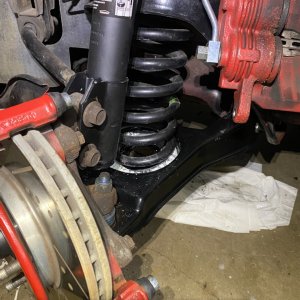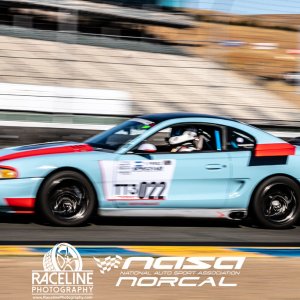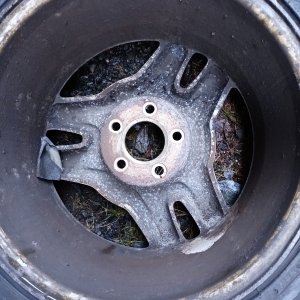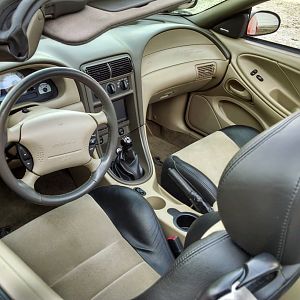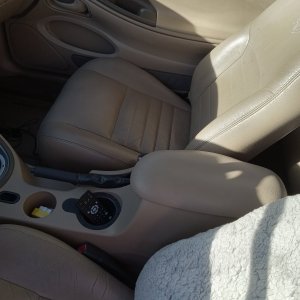Mods I'm nominating this one for a sticky. Every time I research rear suspension for SN95's I'm always taken back to this post that was made on another site by a Maximum Motorsports tech many years ago. I wanted to post it here to make sure it doesn't get lost to the sands of time as I think it can help a lot of members decide what to do with their suspension and better understand how each part effects Roll Bind on the rear suspension of our cars.
"Here's a writeup of a study one of MM's engineers did years ago:
While bind is only one of many parameters determining the handling characteristics of a suspension system, it is useful information, and has been a subject of great debate on these message boards. As part of the research we did in developing our rear suspension system, MM has actually done quite a bit of roll-bind testing. I can offer some hard numbers for everyone to consider. I will define ‘bind’ to be any resistance to wheel movement in a roll situation that is not from the spring or sway bar.
Let me say that this information is not intended to be negative toward any particular system, but should be used to gain understanding of the way cars with different setups feel/handle. This information can help everyone to optimize whatever setup they may have.
Of the tests we have done, following are the tests relating to the rear suspension systems most often discussed. All tests are with the sway bar disconnected, cycling one wheel through 3” bump/droop as if in a roll situation. The results are organized in order from least bind to the most bind.
1) 4 Link - LCA with spherical bearings or rod ends at both ends / Stock UCA’s
6lb/in Linear
This shows the stock upper arms introduce 6 lb/in of wheel rate.
2) 4 Link – MM LCA 3 piece poly, spherical bearing / Stock UCAs
9lb/in Linear
This shows an additional 3 lb/in resistance from our 3 piece urethane compared to a rod end.
3) MMTA/PB – LCA with spherical bearings or rod ends at both ends
10lb/in Linear
Here we removes the 6lb/in from the UCAs, but adds 10lb/in due to lateral deflection of the TA during roll.
4) 4 Link – Stock LCA / Stock UCAs
11lb/in Linear
This shows that the stock LCA adds 5 lb/in of wheel rate, which is actually more than our LCA of case 2.
5) MMTA/PB – MM LCA 3 piece poly, spherical bearing
13lb/in Linear
Again illustrating an additional 3lb/in additional resistance of our 3 piece urethane compared to the rod ends in case 3.
6) 4 Link – LCA with 3 Piece Urethane at both ends / Stock UCAs
26lb/in Linear
Case 6 shows that the 3 piece poly (or any LCA) works best with a spherical bearing at one end. 17lb/in is added over case 2. Note that the effect of adding a 3 piece urethane at only one end adds 3lb/in. Add it at BOTH ends and the increase is 17lb/in… NOT 6 lb/in as one might expect.
7) 4 Link - LCA with delrin, spherical bearing / Stock UCAs
30lb/in Linear
This shows that delrin does not allow necessary angular deflection resulting in an additional 21lb/in over case 2.
8) 4 Link With PB - Stock LCA / Stock UCA
In the first 1” travel 47lb/in
Between 2-3” of travel 30lb/in Decreasing Rate
In case 8 & 9 the Panhard bar defining a new lower roll center is forcing control arms to travel a new path of higher resistance.
9) 4 Link With PB – MM LCA / Stock UCA
In the first 1” travel 50lb/in
Between 2-3” of travel 30lb/in Decreasing Rate
10) 4 Link – Stock LCA / UCA with rod end at chassis, stock rubber at axle
In the first 1” travel 63lb/in
Between 1-2” travel 39lb/in
Between 2-3” travel 20lb/in Decreasing Rate
Case 10 represents trying to locate the axle with a stiffer bushing configuration on the upper control arms. Since the upper arms need to have an effective length change, the rod end in this case actually creates MORE bind.
11) 4 Link – LCA with urethane at both ends / Stock UCA’s
67lb/in Linear
Case 11 is similar to case 6, but shows that a standard poly/poly control arm does not allow much angular change.
Keep in mind that the above information is with no cornering force on the axle. Therefore, there is a huge gap in this information if you are trying to correlate this data to how these systems would feel in use. I would say that the Torque-arm in case 3 & 5 outperforms any other case shown, although it does not have the least amount of bind in this test. We have begun to build a fixture that loads the axle laterally, as if in a corner, to THEN see how the bind behaves. Any system with a Panhard bar should have no significant increase in bind over what is already shown here. This predictability that a PB provides is why we recommend it on a 4 link (with the correct control arms) for people on a budget, or Solo II Street Prepared cars (not allowed to remove uppers). True, you are inducing bind in this situation, but that bind should not significantly change as you load the suspension laterally. When driving the car, the effective added spring rate (from bind) balances well with the new lower RC, and the improved stability and predictability. YES this is a compromise, but I feel it beats trying to locate the axle laterally with stiffer bushings. Obviously, if the pocket book or rulebook permits, the best thing to do is add a Torque-arm and remove the upper control arms. All this binding is also why you are able to add at least 50lb/in wheel rate to the rear when you add a Torque-Arm and remove the UCAs.
Ehren VanSchmus
MM Design Engineer"
"Here's a writeup of a study one of MM's engineers did years ago:
While bind is only one of many parameters determining the handling characteristics of a suspension system, it is useful information, and has been a subject of great debate on these message boards. As part of the research we did in developing our rear suspension system, MM has actually done quite a bit of roll-bind testing. I can offer some hard numbers for everyone to consider. I will define ‘bind’ to be any resistance to wheel movement in a roll situation that is not from the spring or sway bar.
Let me say that this information is not intended to be negative toward any particular system, but should be used to gain understanding of the way cars with different setups feel/handle. This information can help everyone to optimize whatever setup they may have.
Of the tests we have done, following are the tests relating to the rear suspension systems most often discussed. All tests are with the sway bar disconnected, cycling one wheel through 3” bump/droop as if in a roll situation. The results are organized in order from least bind to the most bind.
1) 4 Link - LCA with spherical bearings or rod ends at both ends / Stock UCA’s
6lb/in Linear
This shows the stock upper arms introduce 6 lb/in of wheel rate.
2) 4 Link – MM LCA 3 piece poly, spherical bearing / Stock UCAs
9lb/in Linear
This shows an additional 3 lb/in resistance from our 3 piece urethane compared to a rod end.
3) MMTA/PB – LCA with spherical bearings or rod ends at both ends
10lb/in Linear
Here we removes the 6lb/in from the UCAs, but adds 10lb/in due to lateral deflection of the TA during roll.
4) 4 Link – Stock LCA / Stock UCAs
11lb/in Linear
This shows that the stock LCA adds 5 lb/in of wheel rate, which is actually more than our LCA of case 2.
5) MMTA/PB – MM LCA 3 piece poly, spherical bearing
13lb/in Linear
Again illustrating an additional 3lb/in additional resistance of our 3 piece urethane compared to the rod ends in case 3.
6) 4 Link – LCA with 3 Piece Urethane at both ends / Stock UCAs
26lb/in Linear
Case 6 shows that the 3 piece poly (or any LCA) works best with a spherical bearing at one end. 17lb/in is added over case 2. Note that the effect of adding a 3 piece urethane at only one end adds 3lb/in. Add it at BOTH ends and the increase is 17lb/in… NOT 6 lb/in as one might expect.
7) 4 Link - LCA with delrin, spherical bearing / Stock UCAs
30lb/in Linear
This shows that delrin does not allow necessary angular deflection resulting in an additional 21lb/in over case 2.
8) 4 Link With PB - Stock LCA / Stock UCA
In the first 1” travel 47lb/in
Between 2-3” of travel 30lb/in Decreasing Rate
In case 8 & 9 the Panhard bar defining a new lower roll center is forcing control arms to travel a new path of higher resistance.
9) 4 Link With PB – MM LCA / Stock UCA
In the first 1” travel 50lb/in
Between 2-3” of travel 30lb/in Decreasing Rate
10) 4 Link – Stock LCA / UCA with rod end at chassis, stock rubber at axle
In the first 1” travel 63lb/in
Between 1-2” travel 39lb/in
Between 2-3” travel 20lb/in Decreasing Rate
Case 10 represents trying to locate the axle with a stiffer bushing configuration on the upper control arms. Since the upper arms need to have an effective length change, the rod end in this case actually creates MORE bind.
11) 4 Link – LCA with urethane at both ends / Stock UCA’s
67lb/in Linear
Case 11 is similar to case 6, but shows that a standard poly/poly control arm does not allow much angular change.
Keep in mind that the above information is with no cornering force on the axle. Therefore, there is a huge gap in this information if you are trying to correlate this data to how these systems would feel in use. I would say that the Torque-arm in case 3 & 5 outperforms any other case shown, although it does not have the least amount of bind in this test. We have begun to build a fixture that loads the axle laterally, as if in a corner, to THEN see how the bind behaves. Any system with a Panhard bar should have no significant increase in bind over what is already shown here. This predictability that a PB provides is why we recommend it on a 4 link (with the correct control arms) for people on a budget, or Solo II Street Prepared cars (not allowed to remove uppers). True, you are inducing bind in this situation, but that bind should not significantly change as you load the suspension laterally. When driving the car, the effective added spring rate (from bind) balances well with the new lower RC, and the improved stability and predictability. YES this is a compromise, but I feel it beats trying to locate the axle laterally with stiffer bushings. Obviously, if the pocket book or rulebook permits, the best thing to do is add a Torque-arm and remove the upper control arms. All this binding is also why you are able to add at least 50lb/in wheel rate to the rear when you add a Torque-Arm and remove the UCAs.
Ehren VanSchmus
MM Design Engineer"


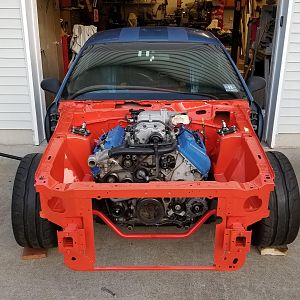
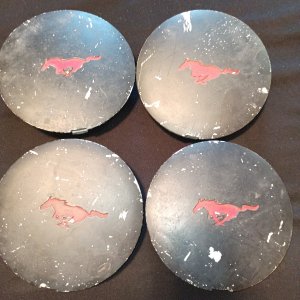
![IMG_20140524_152057360_HDR[1]](/data/xfmg/thumbnail/0/66-1b90088565df25d76ff5bd73b7f47142.jpg?1623783787)
